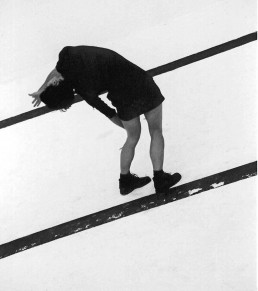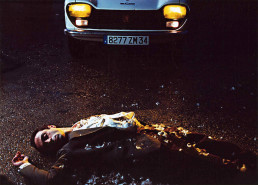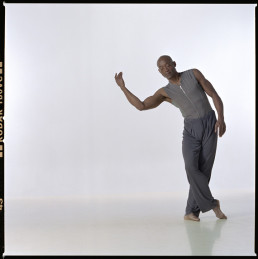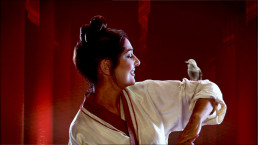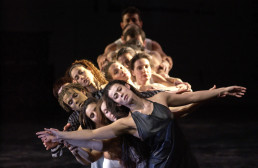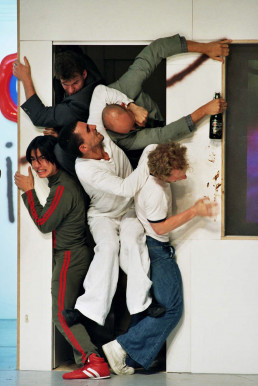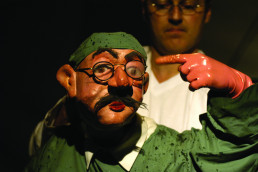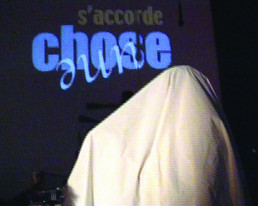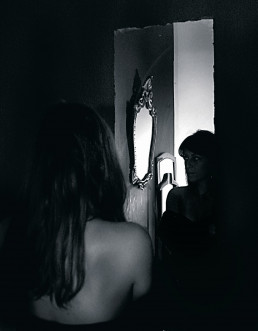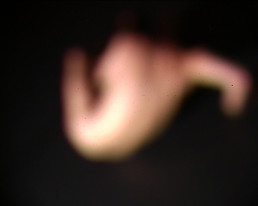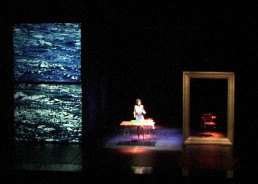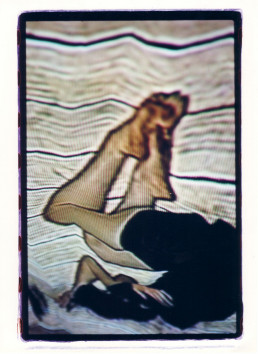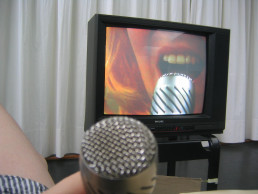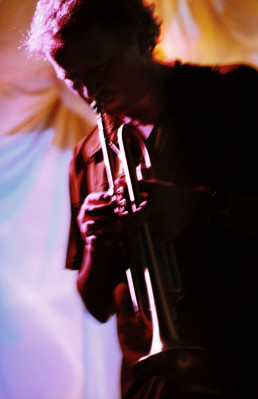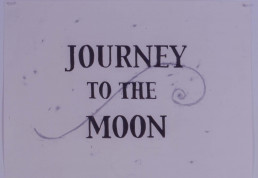“O CORPO É UMA PROJEÇÃO #2”
Projeções e Conferência
O ciclo “O Corpo é uma Projeção”, prossegue na abertura de um espaço de contacto entre as práticas performativas atuais e os seus antecedentes históricos. O seu programa é composto por duas sessões dedicadas ao artista americano Robert Morris com uma mesa-redonda no final, uma outra sessão programada pelo filósofo e crítico de arte Jacinto Lageira, e um seminário de dois dias, centrado nas práticas curatoriais no âmbito da Performance Art, a ter lugar em Fevereiro, em datas a anunciar. Este será dirigido por RoseLee Goldberg, diretora do centro “Performa”, em Nova Iorque, e autora de livros seminais para a história da Performance Art.
Para o artista norte-americano Robert Morris, a arte é um trabalho do corpo. Embora mais conhecido no âmbito das artes plásticas pela sua ligação à Arte Minimal na década de 60, ou à Process Art dos anos 70, Morris tem no seu contacto com a dança pós-moderna americana, um momento crucial para o desenvolvimento de toda a sua obra. “Four Pieces by Morris” (1993), exibido na primeira sessão deste ciclo, é um filme para o qual foram reconstituídas quatro danças inicialmente apresentadas na década de 60. A exibição deste filme será, para uns, a introdução à obra deste artista e, para outros, um momento para reconsiderar a receção do seu trabalho.
Como estas peças que foram concebidas há 4 décadas, mediadas por um filme com pouco mais de 10 anos, teremos a oportunidade de acompanhar Morris na utilização crítica da história da arte – dos seus objetos, imagens e discursos – entrando também na discussão atual acerca da reposição e do arquivo das obras performativas.
No segundo dia assistiremos a um diálogo de imagens entre Morris e a artista Lynda Benglis, com os vídeos “Exchange” e “Mumble”. Feitos alguns anos depois das danças que deram origem a “Four Pieces by Morris”, retomam e transformam imagens e assuntos então abordados, significativos tanto para a obra de Morris como para o aparecimento do vídeo como prática artística. No final desta sessão, haverá lugar a uma mesa redonda onde, partindo dos filmes visionados, se falará da produção escrita e fílmica de Robert Morris, e da performatividade no campo das artes plásticas.
Liliana Coutinho
Four Pieces by Morris | Babette Mangolte
1993, 16mm, P&B, som, 94 minutos
Cortesia de Babette Mangolte
Mumble | Lynda Benglis
1972, vídeo, P&B, som, 20 minutos
Distribuição Video Data Bank, Nova Iorque
Exchange | Robert Morris
1973, vídeo, P&B, som, 36 minutos
Distribuição Video Data Bank, Nova Iorque
Mesa Redonda
Participantes:
Delfim Sardo – Diretor do Centro de Exposições do Centro Cultural de Belém.
Jacinto Lageira – Filósofo, Crítico de Arte, Ensina Estética e História de Arte na Université de Paris-I/Panthéon Sorbonne, Paris.
Phillippe Alain-Michaud – “Film Curator” do Musée National d’Art Moderne – Centre Georges Pompidou, Paris.
Moderadora:
Liliana Coutinho – Mestre em Estudos Curatoriais, pela Faculdade de Belas Artes da Universidade de Lisboa.
Piéce Touchèe | Martin Arnold
1989, 16mm, P&B, som, 16 minutos, exibido em DVD
Why do things get in a muddle | Gary Hill
1984, vídeo, cor, som, 33 minutos
Waterproof | Daniel Larrieu
1986, vídeo, cor, som, 21 minutos
Monstres (rép.) | Jan Kopp
2003, DVD, cor, som, 60 minutos
Consideramos geralmente que estamos mais adaptados a executar certos movimentos e que temos uma capacidade evidente para realizar certos atos (produzir palavras, por exemplo). Estes artistas procuraram saber até que ponto poderiam chegar essas possibilidades físicas e mentais, retomando sob outras formas a questão recorrente de saber se o homem é um ser inacabado ou definitivamente cumprido no seu corpo e na sua linguagem.
Jacinto Lageira
Apoio Institut Franco-Portugais
Agradecimentos Daniel Larrieu; Fabienne Leclerc/Galerie in Situ, Paris; Jan Kopp/Galerie Grégoire Maisonneuve, Paris; Luís Gigante; Musée National d’Art Moderne – Centre Georges Pompidou, Paris; Mme Van Dantzig/Lieurac Production, Paris
Seminário “Curating Performance” com RoseLee Goldberg
RoseLee Goldberg é historiadora de arte especializada em performance. É fundadora, diretora e comissária da Bienal PERFORMA, professora na Universidade de Nova Iorque e autora de uma vasta obra dedicada à performance, onde se destacam as obras “Laurie Anderson” (Nova Iorque, Thames & Hudson, 2000) e “Performance Art: From Futurism to the Present” (Nova Iorque, Thames & Hudson, 1998 e 2001).
Margem Atlântica | Ariel de Bigault
2005, 55 minutos
Com: Mariza, José Eduardo Agualusa, Amélia Muge, João Afonso, Zézé e Miguel Hurst, Kalaf, Space Boys, Ângelo Torres, António Pedro Cerdeira, Kika Santos, Tito Paris, Jon Luz e Bullet
Estreia Mundial
Este filme conjuga diversas facetas de um movimento artístico e cultural, moderno e mestiço, que percorre Lisboa. A capital portuguesa é espaço de uma singular alquimia humana e criativa que, enraizada na Lusofonia, ultrapassa referências e classificações.
Autores, atores e músicos, guiam-nos por um percurso lisboeta, real e poético, um autêntico roteiro de situações e diálogos, textos e músicas, encenações e imagens.
“O CORPO É UMA PROJEÇÃO #2”
Projeções e Conferência
The cycle “The Body is a Projection”, continues in the opening of a space of contact between the current performative practices and their historical antecedents. Its program consists of two sessions dedicated to the American artist Robert Morris with a round table at the end, another session scheduled by the philosopher and art critic Jacinto Lageira, and a two-day seminar centered on performance curatorial practices Art, to be held in February, on dates to be announced. This will be directed by RoseLee Goldberg, director of the “Performa” center in New York, and author of seminal books for the history of Performance Art.
For the American artist Robert Morris, art is a work of the body. Although best known in the field of visual arts for his connection to Minimal Art in the 1960s, or the 1970s’ Process Art, Morris has in his touch with postmodern American dance, a crucial moment for the development of his work. “Four Pieces by Morris” (1993), screened in the first session of this cycle, is a film for which four dances which premiered in the 60’s were reconstituted. The exhibition of this film will be for some the introduction to the work of this artist and, for others, a moment to reconsider receiving their work.
Like these pieces that were conceived 4 decades ago, mediated by a film that was just over 10 years old, we will have the opportunity to accompany Morris in the critical use of art history – of his objects, images and speeches – also entering into the current discussion about repositioning and archiving of performative works.
On the second day we will see a dialogue of images between Morris and the artist Lynda Benglis, with the videos “Exchange” and “Mumble”. Made a few years after the dances that gave rise to “Four Pieces by Morris”, they return and transform images and subjects addressed back then, significant both for the work of Morris and for the appearance of the video as an artistic practice. At the end of this session, there will be a round table where, from the films screened, Robert Morris’ written and film works will be discussed, as well as the performativity in the field of visual arts.
Liliana Coutinho
Four Pieces by Morris | Babette Mangolte
1993, 16mm, B&W, sound, 94 minutes
Courtesy of Babette Mangolte
Mumble | Lynda Benglo
1972, video, B&W, sound, 20 minutes
Distribution Video Data Bank, New York
Exchange | Robert Morris
1973, video, B&W, sound, 36 minutes
Distribution Video Data Bank, New York
ROUND TABLE
Participants:
Delfim Sardo – Director of the Exhibition Centre of Centro Cultural de Belem
Jacinto Lageira – Philosopher, Art critic, Teaches Art history and Aesthetics at the Université de Paris-I/Panthéon Sorbonne, Paris.
Phillippe-Alain Michaud – “Film Curator” of the Museé National d’Art Moderne – Centre Georges Pompidou, Paris.
Moderator:
Liliana Coutinho – Master of Curatorial Studies, by the Faculty of Fine Arts, University of Lisbon.
Piece Touchèe | Martin Arnold
1989, 16mm, B&W, sound, 16 minutes, shown on DVD
Why get the things in the muddle | Hill Gary
1984, video, color, sound, 33 minutes
Waterproof | Daniel Larrieu
1986, video, color, sound, 21 minutes
Monstres (Rep.) | Jan Kopp
2003, DVD, color, sound, 60 minutes
We generally consider that we are most capable of performing certain movements and that we have an evident ability to perform certain acts (producing words, for example). These artists sought to know to what extent these physical and mental possibilities can go, taking up again in other forms the recurrent question of whether man is an unfinished or definitively fulfilled being in his body and language.
Jacinto Lageira
Support Institut Franco-Portugais
Acknowledgements Daniel Larrieu; Fabienne Leclerc/Galerie in Situ, Paris; Jan Kopp/Galerie Grégoire Maisonneuve, Paris; Luís Gigante; Musée National d’Art Moderne – Centre Georges Pompidou, Paris; Mme Van Dantzig/Lieurac Production, Paris
Seminar on “Curating Performance” with Roselee Goldberg
Roselee Goldberg is an art historian expert in performance. She is the founder, director and commissioner of PERFORMA Biennial, a professor at the New York University and author of a comprehensive work devoted to performance, where we highlight the works “Laurie Anderson” (New York, Thames & Hudson, 2000) and “Performance Art: From Futurism to the Present” (New York, Thames & Hudson, 1998 and 2001).
Margem Atlântica | Ariel de Bigault
2005, 55 minutes
With: Mariza, José Eduardo Agualusa, Amélia Muge, João Afonso, Zézé and Miguel Hurst, Kalaf, Space Boys, Ângelo Torres, António Pedro Cerdeira, Kika Santos, Tito Paris, Jon Luz e Bullet
World premiere
This film combines several facets of an artistic and cultural movement, modern and mestizo, that runs through Lisbon. The Portuguese capital is a space of a singular human and creative alchemy which, rooted in the Lusophony, surpasses references and classifications.
Authors, actors and musicians guide us through a real and poetic Lisbon route, an authentic script of situations and dialogues, texts and songs, scenarios and images.


